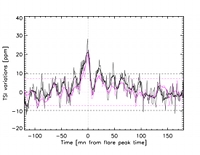SOHO sheds new light on solar flares
12 October 2010
After detailed analysis of data from the SOHO and GOES spacecraft, a team of European scientists has been able to shed new light on the role of solar flares in the total output of radiation from our nearest star. Their surprising conclusion is that X-rays account for only about 1 per cent of the total energy emitted by these explosive events.| This SOHO/EIT sequence records two huge solar flares that were detected in October 2003. (Click here for larger versions of the movie and further details.) Credit: ESA/NASA |
Flares are sudden energy releases in the Sun's atmosphere that occur when the solar magnetic field is locally unstable. When the magnetic field lines break and reconnect, large amounts of energy are released, accelerating the surrounding particles to almost the speed of light. The temperature of the flares can soar to millions of degrees. At such sizzling temperatures, much of their radiation is emitted as X-rays.
Not surprisingly, most flares are imaged and studied at X-ray or extreme ultraviolet wavelengths, since they are more difficult to observe and analyse in visible light. Although more than
In an effort to calculate how much energy is actually contributed to the TSI by flares, researchers from the Laboratoire de Physique et Chimie de l'Environnement et de l'Espace (LPC2E) in Orléans (France), collaborating with Swiss and Belgium teams, have been analysing 11 years of observations from space.
The team analysed the record of X-ray data acquired by the US GOES spacecraft during the entire solar cycle to detect the flares and record the times of their peak activity. The scientists eventually selected about 2000 flares which occurred near the centre of the solar disc. They then turned to the PMO and DIARAD radiometers of the VIRGO experiment on board the ESA/NASA SOHO spacecraft for information about the overall solar radiation heading toward Earth.
The next task was to identify any small peaks in TSI caused by the flares. This task was complicated by the random 'noise' generated by the Sun's turbulent atmosphere. In order to recognise the contribution due to flares alone, the team used a statistical method to superimpose X-ray and TSI data taken at short time intervals around the period when a flare occurred. In this way, they were able to remove the random 'noise' from the data.
"The problem was to recognise the overall output from flares, radiated simultaneously at all wavelengths and in the visible domain, despite the natural fluctuations of the solar irradiance," said Matthieu Kretzschmar, researcher at the LPC2E and first author of the study in Nature Physics. "It is like looking for 1-metre-high waves, caused by flares, within a rough sea where there are 70-metre-high waves caused by natural fluctuations."
"To solve this problem, we amplified the 'one-meter-high waves' using the 'superposed-epoch analysis' method. The idea was to temporally superpose the total irradiance light curves for several flares. Natural random fluctuations in the solar irradiance cancel each other out, but the fluctuations caused by the flares are added and amplified."
The analysis led to a surprising result: there was a significant peak in the TSI when a flare occurred. Not only was the total radiative output of the Sun sensitive to both large and small flares, but the total energy radiated by flares was found to be over 100 times greater than the energy that they radiate in X-rays. It turns out that X-rays contribute only a tiny part of the overall output of radiation during solar flares.
These results, obtained within the framework of the European Community's SOTERIA project, will help to improve current theoretical models of flares and understanding of the variability in the solar irradiance that reaches our planet. They could also help to shed light on the behaviour of more distant stars, some of which may also host planetary systems.
"Many stars are much more active than our Sun and emit extremely powerful flares," said Bernhard Fleck, ESA's SOHO Project Scientist. "This new estimate of the energy distribution of solar flares suggests that such flares may be extremely bright in visible light as well as X-rays, possibly with dramatic consequences for any nearby planets."
Related publication:
M. Kretzschmar, T. Dudok de Wit, W. Schmudtz, S. Mekaoui, J.F. Hochedez, S. Dewitte, "The effect of flares on total solar irradiance", Nature Physics, vol. 6, pp. 690–692, 2010. DOI: 10.1038/nphys1741
Contacts:
Matthieu Kretzschmar
LPC2E: Laboratoire de Physique et Chimie de l'Environnement et de l'Espace
CNRS / Université d'Orléans, France
Email: matthieu.kretzschmar cnrs-orleans.fr
cnrs-orleans.fr
Phone:+33 2 38 25 50 39
Bernhard Fleck
ESA SOHO Project Scientist
Science Operations Department
Science and Robotic Exploration Directorate, ESA
Email: bfleck esa.nascom.nasa.gov
esa.nascom.nasa.gov
Phone: +1 301 286 4098



